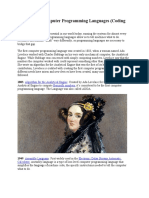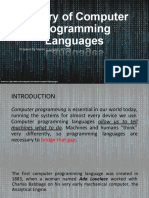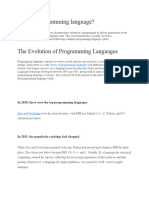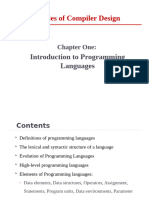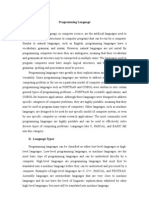Module 2 - COSC95 - Evolution of Major Programming Language - VCB
Uploaded by
April VasquezModule 2 - COSC95 - Evolution of Major Programming Language - VCB
Uploaded by
April VasquezRepublic of the Philippines
CAVITE STATE UNIVERSITY
Silang Campus
Biga I, Silang, Cavite
046 513-5706 046 513-3965
✉ cvsusilang@cvsu.edu.ph
DEPARTMENT OF INFORMATION TECHNOLGY
COSC 95 - Programming Languages
Module 2 – Week 4-5
Evolution of Major Programming Language
Overview
In this world of technological advancement, there may be very few environments where there is no
application of programming languages. When it comes to technology, the programming language
is in the heart of it all. It is an integral part of the machine or system which allows it to function and
behave as it should. It is a vital organ to any system that lets it perform its concerned logical actions.
It has laid the foundation in the field of worldwide connectivity. The code written into the machine
allows it to think and perform its designated task. So, without the birth of programming language,
technological advancement would not have been possible.
Objectives
After working on this module, you will be able to:
1. Understand the evolution of programming languages.
2. Identify the sequence of development of programming languages.
History and Evolution of Major Programming Languages
The programming languages have been in development since the mid-eighteen hundreds to
present. The first programming language ever created was more than 100 years ago. In order to
pay tribute to the programming languages that have been developed for generations, we will go
through a brief history of programming languages and their usages.
COSC 95 – PROGRAMMING LANGUAGES GIO BAUTISTA- SECOND SEMESTER AY 2021-2022
1883: First Programming Language
A woman named Ada Lovelace devised the first programming language in 1883. She worked with
Charles Babbage (who we all know as Father of Computers) in his first mechanical computer called
Analytical Engine. Lovelace analyzed how numbers operated in computers and discovered that
they could represent a pattern or flow. Then, she devised a pattern for the Babbage Engine to
compute the Bernoulli numbers, which is considered to be the first programming language.
With this, Ada was credited with developing the first programming language.
1957-1959: FORTRAN, COBOL and LISP
In these 3 years, programming languages like FORTRAN, COBOL, and LISP were created.
FORTRAN was designed for complex mathematical, scientific and statistical operations. Fortran
stands for formula translation and the credit for its creation goes to John Backus. This language is
still widely utilized in mathematical analysis and computations. COBOL developed by Dr. Grace
Murray Hopper is a Common Business Oriented Language. This language could operate on any
type of computer. The applications of this language are in banking, telephone systems, credit card
processing, hospital and government computers, automotive systems, and traffic signals. LISP is a
list processing language devised by John McCarthy created for its application in Artificial
Intelligence.
COSC 95 – PROGRAMMING LANGUAGES GIO BAUTISTA- SECOND SEMESTER AY 2021-2022
1970: Pascal
The credit for the creation of Pascal language goes to Niklaus Wirth. It was named Pascal to pay
tribute to French mathematician, philosopher, and physicist Blaise Pascal. It is a high-level
programming language considered a pretty easy learning curve. The main purpose of its
development was to teach computer programming. The teaching involved structured programming
and data structures. The derivative of Pascal called Object Pascal was commonly used for windows
application development. It was also used by Apple Lisa and Skype.
1972: C
All the programmers and people from technical backgrounds would have heard of the C language.
It is considered to be the most initial high-level language by many. This high-level language is closer
to natural language putting away the complex machine codes. It was developed by Dennis Richie
in Bell labs.
The main purpose of its creation was for the Unix Operating System which is popular nowadays as
an open-source operating system. This language was a foundation for many different languages
that would be created in the future. This language was the base for Java, C#, JavaScript, Ruby,
Go, Perl, Python, and PHP. It was primarily used in cross-platform programming, system
programming, Unix programming, and game development.
COSC 95 – PROGRAMMING LANGUAGES GIO BAUTISTA- SECOND SEMESTER AY 2021-2022
1983: C++
C++ is considered the extension of C language with the capability of Object-Oriented
Programming. The enhancements such as classes, virtual functions, and templates were made.
The credit for the creation of this language goes to Bjarne Stroustrup, It is one of the most popular
and widely used languages. This language is highly used for game development tools to program
game engines as well as in high-performance software like PhotoShop. C++ was also used to
develop other scripting languages and its frameworks like NodeJS. The primary application is in
commercial application development, embedded software, client/server applications, etc.
1983: Objective C
Objective C is the object-oriented extension over C language devised by Brad Cox and Tom Love
in Stepstone. It is a general-purpose, high-level language with the addition of message-passing
functionality based on Smalltalk language. The main purpose of this language was for Apple
programming. It was mainly used for coding software for macOS and iOS, Apple operating systems.
COSC 95 – PROGRAMMING LANGUAGES GIO BAUTISTA- SECOND SEMESTER AY 2021-2022
1987: Perl
Perl is a scripting language designed mainly for editing text. It was developed by Larry Wall in
Unisys. It was developed for report processing on Unix systems. It is known for its high-power
performance, modularity and versatility. The primary uses of Perl are for computer graphics CGI,
database applications, web programming, system administration, and graphics programming. This
language is used by Amazon, IMDb, etc.
1991: Python
Python is considered one of the easiest programmings to learn. The learning curve is quite flat and
recommended for coding beginners. The fact is that this language is very close to human language.
The coding mechanism is very simple and programmers can do multiple tasks with just single
coding expressions. This language was developed by Guido Van Rossum. The frameworks coded
in python language are used by popular social media apps like Instagram. This language is widely
used nowadays for machine learning and AI. It is also used for web applications, software
development, and information security.
COSC 95 – PROGRAMMING LANGUAGES GIO BAUTISTA- SECOND SEMESTER AY 2021-2022
1993: Ruby
In 1993, many popular and powerful languages were developed. Ruby was one of those
programming languages. This language was designed by Yukihiro Matsumoto originally for
teaching purposes. This language is influenced by Perl, Ada, Lisp, Smalltalk, etc. The language is
very productive and enjoyable. It is used for web application development and also the foundation
for Ruby on Rails. It is used by Twitter, Hulu, etc. The execution of the code is slow, but it allows
programmers to put the code together quickly and run a program.
1993: Java
Java is one of the most widely used and popular programming languages all across the globe. This
language was developed by Sun Microsystems. This language has huge use cases. Primarily, this
language was intended for networking tools and mobile devices but was enhanced to facilitate
information across the World Wide Web. This language can be found anywhere from huge power
servers to small mobile devices. The applications of this language are very widely distributed from
network programming, web applications, software development, mobile application development to
GUI development. It is used in the development of native Android OS apps as well.
COSC 95 – PROGRAMMING LANGUAGES GIO BAUTISTA- SECOND SEMESTER AY 2021-2022
1993: PHP
PHP is a widely known and used language for dynamic web programming. This programming
language is mainly used to compile on web servers to serve the web pages and required resources.
It was created by Rasmus Lerdorf. It was originally named Personal Home Page but was later called
Hypertext Preprocessor. The major application of this language was to build dynamic web pages
and server-side development. This language was widely used by popular companies like Facebook,
Wikipedia, WordPress, etc.
1993: JavaScript
JavaScript is a web scripting language known to all web developers. It was developed by Brendan
Eich. It is primarily used along with web pages for web browser interactions. We can say that almost
every web page uses JavaScript. It is a high-level scripting language used to make web pages
dynamic at the client-side without putting pressure on the server-side. It is used for web form
submission and validations, user interface interactivity, animations, and tracking.
JavaScript takes the load of the server-side by running in the user's computer and doing most of
the client-side computation which does not require data from the server. Today, JavaScript has
expanded itself to different frameworks and can be used to develop web applications, websites,
server-side programs, desktop applications, and mobile applications as well. JavaScript has no
boundaries in the field of programming in a modern programming environment.
COSC 95 – PROGRAMMING LANGUAGES GIO BAUTISTA- SECOND SEMESTER AY 2021-2022
2000+
Many new programming languages and frameworks were created after the 2000s. Most of the
languages and frameworks were based on the older programming languages with powerful
extensions and security. Some of the honorable mentions are React JS, Angular, C#, Scala, Go,
Swift, etc. C# is an extension of C++ language with the simplicity of Visual Basic incorporated into
it. C# was primarily used to develop the Microsoft products and desktop applications.
Scala is the programming language that integrates functional programming with object-oriented
programming. Swift is another powerful programming language devised by Apple as the
replacement of Objective C. Swift just like objective C is used to develop the Apple software and
applications with more simplicity and efficiency.
The modern world cannot be free of programming language now. They have formed a foundation
for powerful systems and technology to grow. Programming languages inspired innovation,
development, and ability to turn the physical world into virtual, making tasks easier and enjoyable.
Most of the programming languages that are prevalent today are built upon the concept of older
programming languages.
The new ones make the work simpler and efficient with fewer chances of errors and a high level of
security. Machine learning, data mining, Artificial Intelligence all use programming languages as a
core ingredient. Many businesses rely heavily on software programs to run day to day tasks
efficiently. So, this programming environment will only develop in the future with more modular,
simplistic, and powerful coding languages.
Conclusion: Programming languages are still in the process of evolution in both industry as well
as in research. Only time will tell where this journey of programming languages will reach and what
this technology will look like when it reaches its pinnacle.
Activity 2
(Video Activity) Choose one partner from your class then create a 5-minute video
comparison of those programming languages together with your partner based from
your chosen programming language that you are familiar with. You may refer below for the
parameters and flow on how you compare your chosen programming languages:
• Preprocessors/Directives
• Variable declarations Note: You can use power-point
presentation or any
• Conditional statements
applications/tools that will assist
• Looping statements you for your recording. Once done
you may post a video link in Google
• Operators
Classroom for evaluation.
• Logical operators
• Comparison operators
• Arithmetic operators
COSC 95 – PROGRAMMING LANGUAGES GIO BAUTISTA- SECOND SEMESTER AY 2021-2022
You might also like
- A History of Computer Programming Languages100% (1)A History of Computer Programming Languages5 pages
- Earlywatch Alert - P01 1 Service SummaryNo ratings yetEarlywatch Alert - P01 1 Service Summary78 pages
- Module 1 - COSC95 - Introduction To Programming Languages - VCBNo ratings yetModule 1 - COSC95 - Introduction To Programming Languages - VCB11 pages
- Principles of Programming Language: D.P.Sudeep Andhra UniversityNo ratings yetPrinciples of Programming Language: D.P.Sudeep Andhra University40 pages
- 20th Century Programming Languages Timeline100% (1)20th Century Programming Languages Timeline4 pages
- Homework 1 Research Paper: A Complete History of Programming LanguagesNo ratings yetHomework 1 Research Paper: A Complete History of Programming Languages12 pages
- Programming Languages - Current and Historical, Nemanja CvejićNo ratings yetProgramming Languages - Current and Historical, Nemanja Cvejić10 pages
- History of Programming Language: Ada Lovelace's Machine AlgorithmNo ratings yetHistory of Programming Language: Ada Lovelace's Machine Algorithm5 pages
- Lesson 1 - The Evolution of Programming LanguageNo ratings yetLesson 1 - The Evolution of Programming Language32 pages
- Assignment No 1 (Programing Fundamental)No ratings yetAssignment No 1 (Programing Fundamental)4 pages
- Grade 11 Com Prog 1 History of Computer ProgrammingNo ratings yetGrade 11 Com Prog 1 History of Computer Programming16 pages
- C Programming Language, A Step By Step Beginner's Guide To Learn C Programming In 7 Days.From EverandC Programming Language, A Step By Step Beginner's Guide To Learn C Programming In 7 Days.3.5/5 (7)
- Categories of Programming Languages - What You Need To Know - Maryville OnlineNo ratings yetCategories of Programming Languages - What You Need To Know - Maryville Online1 page
- Chapter01 IntroductionToComputerProgrammingNo ratings yetChapter01 IntroductionToComputerProgramming23 pages
- C Programming : All-in-One Resource for C Programming , Comprehensive Tutorials, Expert Tips, and a Wide Range of Exercises for All Skill LevelsFrom EverandC Programming : All-in-One Resource for C Programming , Comprehensive Tutorials, Expert Tips, and a Wide Range of Exercises for All Skill LevelsNo ratings yet
- C Programming: C Programming Language for beginners, teaching you how to learn to code in C fast!From EverandC Programming: C Programming Language for beginners, teaching you how to learn to code in C fast!No ratings yet
- Week 2 - Assignment No.1 Camacho, John Patrick S April 14, 2021 Sbit-2F IPT101 Integrative Programming and Technologies 1No ratings yetWeek 2 - Assignment No.1 Camacho, John Patrick S April 14, 2021 Sbit-2F IPT101 Integrative Programming and Technologies 17 pages
- Sumbilon, Austine Couline G. Basic Computer Bsit-2Nd YearNo ratings yetSumbilon, Austine Couline G. Basic Computer Bsit-2Nd Year8 pages
- C - Dennis Ritchie: BASIC - John Kemeny & Thomas KurtzNo ratings yetC - Dennis Ritchie: BASIC - John Kemeny & Thomas Kurtz4 pages
- PRINCIPLES OF PROGRAMMING LANGUAGES NotesNo ratings yetPRINCIPLES OF PROGRAMMING LANGUAGES Notes88 pages
- SAP EDI, IDOC, and Interfacing Interview Questions, Answers, and Explanations ......................................... XiNo ratings yetSAP EDI, IDOC, and Interfacing Interview Questions, Answers, and Explanations ......................................... Xi214 pages
- A Gentle Introduction To Algorithm Complexity AnalysisNo ratings yetA Gentle Introduction To Algorithm Complexity Analysis33 pages
- Photo Booth Tutorial App: What You'll BuildNo ratings yetPhoto Booth Tutorial App: What You'll Build8 pages
- WFO Consolidated Software Lineup Matrix Date: Aok Doc IdNo ratings yetWFO Consolidated Software Lineup Matrix Date: Aok Doc Id36 pages
- SENG 421: Software Metrics: Goal-Based Software Measurement Framework (Chapter 3)No ratings yetSENG 421: Software Metrics: Goal-Based Software Measurement Framework (Chapter 3)139 pages
- Coding Sites - : Hackerearth or Hackerrank InterviewbitNo ratings yetCoding Sites - : Hackerearth or Hackerrank Interviewbit4 pages
- JSR 311: Jax-Rs: The Java™ Api For Restful Web Services: Marc Hadley, Paul Sandoz, Roderico CruzNo ratings yetJSR 311: Jax-Rs: The Java™ Api For Restful Web Services: Marc Hadley, Paul Sandoz, Roderico Cruz36 pages
- Yealink Configuration Encryption Tool User Guide V9.10No ratings yetYealink Configuration Encryption Tool User Guide V9.1011 pages
- Full Download Codeless Data Structures and Algorithms: Learn DSA Without Writing A Single Line of Code Armstrong Subero PDF100% (3)Full Download Codeless Data Structures and Algorithms: Learn DSA Without Writing A Single Line of Code Armstrong Subero PDF62 pages
- TM01 Website Technical Reqirement ModelingNo ratings yetTM01 Website Technical Reqirement Modeling37 pages

